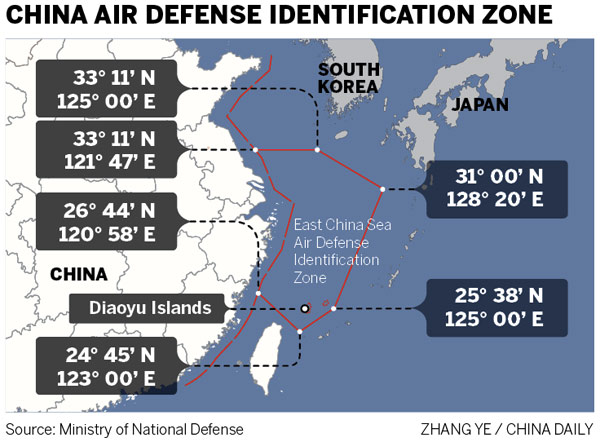Airplanes' skirmish still debated
Updated: 2014-08-26 10:09
By Chen Weihua in Washington(China Daily USA)
|
||||||||
 |
|
A US Navy P-8 Poseidon aircraft takes off from Perth International Airport in this April 16, 2014 file photo.[Photo/Agencies] |
The close encounter of a Chinese People's Liberation Army Navy fighter jet and a US Navy reconnaissance plane off Hainan Island in the South China Sea has again raised concerns about the long-standing issue of US frequent spying along China's coast.
 |
| China rejects US claim of midair intercept |
Yang called US accusations against China "groundless", adding that "the US' large scale and frequent and close reconnaissance is the real source of air safety concerns and possible accidents."
Yang said China has urged the US to take concrete action to reduce and ultimately end its close reconnaissance near China's coast in order to create a better environment for improving bilateral military-to-military ties.
Yang's words came in response to the accusation by Pentagon Press Secretary John Kirby on Friday who said an armed Chinese fighter jet conducted a dangerous intercept of a US Navy P-8 Poseidon patrol aircraft.
"The Chinese jet passed the nose of the P-8 at 90 degrees with its belly toward the P-8 Poseidon, we believe to make a point of showing its weapons load out," Kirby said.
"They flew directly under and alongside the P-8, bringing their wingtips to within 20 feet and then conducted a roll over the P-8, passing within 45 feet," he said.

Zhiqun Zhu, director of the China Institute and professor of political science and international relations at Bucknell University, believes the fundamental problem to the latest dispute is that the two countries have not built up enough trust after so many years of effort.
"This is a dj vu of 2001. While the US feels entitled to fly such spying missions in the international space, China feels bullied by such acts of hostility," Zhu said.
He was referring to the Apr 1, 2001 collision of a Chinese PLA Navy J-8 fight jet and a US Navy EP-3 spy plane off China's Hainan Island in the South China Sea. The collision caused the death of Chinese pilot Wang Wei and the forced landing of EP-3 on Hainan Island.
The 24 US crew members were detained for 11 days and then released after the US said it was "very sorry" for the death of the Chinese pilot and for entering China's airspace without verbal clearance. The EP-3 was only allowed to leave China in July that year after it was dismantled and shipped back by a cargo plane.
Zhu said very few in the US ask why the US would spy on China so frequently and so close to China in the first place.
"It is interesting that the US side accused China of flying dangerously, but from China's perspective, it is the US that has long been provocative by flying such reconnaissance missions," Zhu said.
"Is this the way to treat an equal partner or a trusted friend?" Zhu asked.
He believes that as China's military becomes more powerful, it will become less tolerant of such US missions. "So unless the two militaries work out some protocol to manage such encounters, the risk of collision will increase in the years ahead," he said.
Zhang Junshe, deputy head of the PLA Naval Research Institute, said the US has dispatched large numbers of planes and ships for reconnaissance near China's coast.
Writing in the People's Daily on Monday, Zhang described the US reconnaissance as covering the Yellow Sea, East China Sea and South China Sea, spanning from the coast near Dalian in northeast China to Hainan Island in south China. He described the frequency as 500 flights a year and each lasting more than 10 hours.
Zhang said the frequent US reconnaissance near China's coast has posed a major threat to China's national security.
"People can't help asking that since leaders from the US president to the defense secretary and military commanders have all publicly expressed that they don't see China as enemy and the 'US pivot to Asia Pacific' strategy is not aimed at China, why the US still conducts such intense reconnaissance against China?" Zhang said, adding that the US should give a good explanation.
After the Pentagon statement, the Aug 19 encounter has also been widely covered by the Chinese news media. Zhejiang-based Qianjiang Evening News carried an article on Monday, detailing the US P-3 Orion and P-8 Poseidon reconnaissance planes that were spotted along China's coast on Aug 19.
Writing on sina.com, commentator Zhan Hao described the incident as a demonstration of China's red line. "It means the days that the US can conduct reconnaissance in this airspace swaggeringly should be over," he wrote.
Douglas Paal, vice-president for studies and director of the Asia program at the Carnegie Endowment for International Peace, said he trusted the US pilots to tell the truth about what they saw.
"After all the military-to-military interaction recently, this is really disappointing and potentially dangerous," Paal said.
In an earlier statement, former US National Security Advisor Zbigniew Brzezinski said he was upset by the amount of US forward reconnaissance near China's shores. He believes the US should reduce such activities.
chenweihua@chinadailyusa.com

Most Viewed
Editor's Picks

|

|

|

|

|

|
Today's Top News
Lawmakers in move to tackle espionage threat
Airplanes' skirmish still debated
Mugabe a frequent visitor to China
Australian MP apologizes for insulting Chinese
US hypersonic weapon destroyed seconds after launch
Cathay Pacific to launch new Hong Kong, Boston route
Duke Kunshan welcomes its first class in China
Consulate pioneers Facebook-diplomacy
US Weekly

|

|














